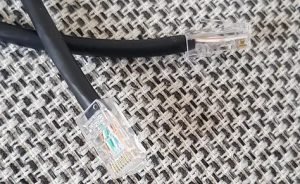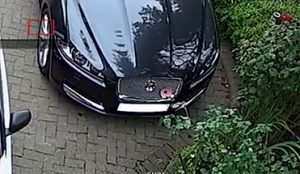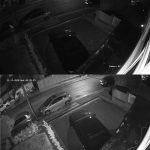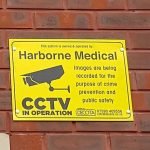CCTV FAQs
CCTV Frequently Asked Questions
DVR stands for digital video recorder.
These record uncompressed images using coaxial cable, they compress these images to a digital signal to enable viewing on your devices.
The DVR system uses analogue cameras.
N.B. you can use ethernet cables with the addition of balun’s instead of coaxial cable, but you will still only own an analogue system.
NVR stands for network video recorder.
As the name suggests, these record images via a network using Cat5 or Cat6 ethernet cables.
The NVR system uses IP (Internet Protocol) cameras, these cameras capture digital Images at the source and use the NVR for recording these images.
In the past the video quality of DVR systems lagged behind NVRs, today this gap is significantly less due to the advancement in analogue technology, this improved picture quality is achieved at the sacrifice of real-time recordings, with most DVRs only recording at 12 FPS or less. Although this is still normally good enough for video playback in most applications.
NVR systems still have better picture quality and normally record at 25 FPS or greater, they have more flexibility and are more ‘future protected’ than DVRs.
In our opinion, we would install an NVR and IP cameras if you are installing a new system and would only install a DVR with 2MP analogue cameras or greater if you are upgrading a system that is already cabled over coax to save the cost and labour of replacing the cables.

Your choice of DVR or NVR will decide if you need analogue or IP cameras. Following this you will need to consider the quality of the camera you need, this is normally measured in image resolution or megapixels. Megapixels are actually a measurement of the number of pixels displayed in your image & not necessarily the quality of it.
So do more megapixels in a camera mean better image quality? Not always!
The lens choice and the quality of the components used in the camera, including the image sensors & image processors all play important roles in producing superior images.
If these components are equal in quality to the higher quantity of megapixels in your camera, the images recorded will definitely be higher quality.
Do you really need 4K security cameras? Probably not!
A good rule of thumb is to use the right amount of resolution versus the purpose of the camera and not use the highest resolution simply because it’s available.
If you want to capture number plates and recognise people’s faces, use a minimum of 2MP cameras for distances of up to and around 6 meters, but this calculation doesn’t allow for the lighting, the position of the camera and the angle of view which could all make reading number plates or identifying people more difficult.
If you want to monitor a larger area of your property or identify number plates at greater distances, use at least 4MP cameras, using higher definition cameras may also require a higher definition DVR or NVR.
One of the main advantages of 4MP and greater cameras is the combination of the larger field of view and better quality images, however, if you just need to monitor a smaller area or somewhere close by, such as the entrance or approach to your property a 2MP camera is perfect.
In summary, the greater the number of megapixels, the larger the field of view and the better & sharper the images are, these can be ‘overkill’ if you are capturing something nearby.

Analogue over Coax.
RG59 coax cable is the industry standard and the best choice for CCTV systems over coax, however, not all RG59 cable is equal.
Coax cable is available in 50 ohms, 75ohms and 93 ohms. The impedance of CCTV cameras is 75 ohms. So it is important to only use 75 ohms cable to have minimum video loss. (Impedance is a measure of resistance, in the cable).
Some RG59 coax cables, especially the ones used for Cable TV have a steel or copper-plated steel conductor instead of pure copper, steel has a much higher resistance than pure copper which leads to poorer image quality and/or video loss.
Steel costs less than copper, which makes this an attractive option for some installers who don’t fully understand the implications of what they are installing.

Analogue over Ethernet with Baluns
See Digital below for the overview on Ethernet cables.
These can be used with the addition of Baluns to transfer your analogue signal, the one downside of this method is the Ethernet cable is designed for RJ45 connectors and not baluns, for this reason, you may find that the wires are easily broken when connected to a standard balun, leading to signal or power loss.
The upside to this type of cabling is that you are future protecting your installation should you be thinking of upgrading to an IP system in the future, Although we would recommend (budget allowing) you always install the latest equipment available.

Digital / IP over Ethernet.
There are lots of options when it comes to Ethernet cables:
Which version – CAT5, 5e, 6 or 6a, Shielded or Unshielded, Gauge, Stranded or solid, Cooper or CCA (cooper clad aluminium)?
A solid copper core of a thicker gauge, ideally 23AWG is the better choice of cable.
Shielding can be used around each of the 4 pairs of cables within the Ethernet cable to protect the wires from interference further. It is designed for use in areas with high interference, such as running cables along the same routes as electrical cables, along steel frames or in metal-clad buildings.
For most CCTV installations, we can choose routes that have minimal impact from these types of interference meaning the extra expense of shielded cables can be avoided. These cables are described as FTP – Shielded and UTP Unshielded.
The gauge of the wire is a measurement of its conductors’ thickness and this is measured in AWGs.
A 23AWG cable is 0.57mm wide, while a 24AWG cable is 0.52mm wide, so the lower the gauge the thicker the cable, this is very important for your CCTV installation, as the wider the cable the easier it is for the signal to pass through it, meaning less resistance leading to less interference, better quality images and more fluent viewing, plus with thicker cables there is a lower risk of poor termination in the connectors and the cables breaking.
Stranded cable is more flexible and would typically be used at your desk or anywhere there may be potential for a lot of movement on the cable. Whereas solid cable is not as flexible, this means it’s more durable, which makes it ideal for permanent installations as well as outdoors and on walls.
Copper Clad Aluminium (CCA) or full copper cables? CCA cables are designed with an aluminium conductor at the core which is coated in copper. This production technique uses less copper, offering a low-cost way for companies to produce Ethernet cables, but what are the hidden costs? CCA cables do not comply with industry-standard specifications, therefore officially there is no such thing as a CCA Cat5e, 6 or 6a cable, although they are advertised as these cables.
More importantly, CCA cables are not designed to withstand Power Over Ethernet (POE), POE allows network cables to carry electrical power to power your cameras. If these cables are used for POE, the cables can overheat, with the initial temperature increase being twice the increase seen from a pure copper lead and if the cables contain stranded CCA conductors, the impact of the heating will be greater still, at best this may cause your CCTV to fail, at worst it’s a FIRE RISK.
Also aluminium has a much higher resistance than pure copper which leads to poorer image quality, video lag and/or video loss. Plus, aluminium is also very reactive and is prone to oxidizing when exposed to air. This may cause failed terminations and broken wires and even without this issue the CCA conductors are brittle and break easily, the wires may break as a result of pulling or moving them, It’s also important to note that the bend radius of CCA cabling is limited, creating a higher risk of breakage during installation.

What lens you need is determined by what you want to view, this is called the optical range and it’s the distance at which detail can be captured. Not to be confused with the IR range, this is the distance that the Infa red night vision works effectively.
Below is an approximate guide to the optical range of different lenses on a 2MP camera, this is the distance at which a number plate or a person should be identifiable.
2.8mm lens 3 meters: 3.6mm lens 6 meters: 6mm lens 10 meters: 9mm lens 12 metres
12mm lens 14 metres : 22mm lens 24 metres : 60mm lens 70 metres
For most homes, a wide angle lens of 2.8mm or 3.6mm is more appropriate as you are only monitoring images in the immediate area and these lenses also give you a greater field of view, avoiding the expense of needing extra cameras to give you the same coverage.
Although fixed and variable lens cameras once fitted have a fixed field of view, most systems allow you to zoom in on the image using your viewing device, this in simple terms is ‘blowing up’ the image and if done with lower definition cameras or zoomed too much, the image will start to pixelate.
You can see an example of a professional 2MP camera with its normal view and the image ‘blown up’ in the pictures below shows how good the image quality is at approximately 6 meters.


The ability to film in low light conditions or even complete darkness is essential for CCTV.
Most modern cameras have built-in IR (infrared) lights. Getting good quality cameras, with good quality components is important and always gives you better results in low light.
The infrared light isn’t visible to the human eye, however, you will notice a ring of red dots/lights on most cameras when you look directly at your camera. The IR CCTV cameras change to black & white as light levels fall and the IR bounces off the first surface in its direct line of sight to reflect the infra-red light so your camera can see in the dark, so it’s important not to obscure the view and keep your cameras clean. Spider webs have a habit of appearing on your lens and it’s important to keep foliage cut back etc.
If you have motion floodlights in your garden or street lights outside, these will all help improve your images.

Motion detection recording is a feature of most DVR and NVR recorders. The recorder monitors camera images and decides if there is movement. To do this it reviews individual image frames and compares them to the previous frame, if it sees differences then motion is assumed to have taken place. It is the recorder and not the camera that is looking for movement.
The recorders aren’t as intelligent as humans & can’t differentiate between background movement, changes in light or someone coming to break into your home. To help minimise false triggers it’s possible to select areas on the screen to detect movement, you can set up the trigger areas by navigating the menus on the DVR / NVR.
Some people only record footage when motion is detected in an attempt to extend the length of time their footage is stored. We are not in favour of doing this as it’s better to install a larger memory and use motion triggering to create bookmarks within your 24/7 recording, using it to identify which sections may be important but still have constant footage.
Operators who use only motion detection are usually trying to compensate for too little memory. We recommend allowing a minimum of 500GB of hard drive space per camera which should give you about 2 weeks of footage based on Cameras up to 5MP & you will need to consider using 1TB per camera if you’re installing 4K cameras.

Modern CCTV Systems store their footage on an internal hard drive similar to computers, but DVRs and computers are different. Unlike a computer, your DVR is designed to run 24 hours a day with a continous data transfer.
For this reason it is important that your hard drive is specifically designed for CCTV systems rather than standard computer drives which have a tendency to fail prematurely.
There are a number of factors that will determine how many days footage your CCTV hard drive store.
The main things to consider are:
Higher definition & quality Images will use more memory meaning less footage, for example a 4MP camera will use twice the memory versus a HD 1080P (2MP) definition camera.
It is possible to lower the recording quality of your recordings to increase your saved footage i.e. a 4MP camera could be set to record at 2MP, but we would always recommend you consider a larger memory rather than sacrifice your image quality.
The number of frames per second you record will affect the amount of memory used, your recorder will have a default setting and this can normally be amended. If you record at 25FPS this would give you approximately twice the recording compared to recording at 12FPS. However, you would lose 13 frames of detail in your recordings. ‘Realtime’ is 25 FPS and you should ideally be aiming for this as a minimum.
Each camera you have on your system requires space for its footage to be stored. Two cameras will take up twice the storage versus one camera, three cameras will take up 3 times the storage versus one camera and so on.
We recommend a minimum of 500MB per camera, which should give you about two weeks of footage based on an HD camera with around 2MP to 4MP quality, meaning a two-camera system will have 1TB hard drive to give around two weeks’ worth of footage, a four-camera system will have a 2TB hard drive and so on.

PTZ stands for pan, tilt, zoom.
A PTZ camera can be remotely controlled allowing it to move up, down, left, right and zoom in and out.
In theory, PTZ cameras sound great, they can cover large areas and even zoom in when more detail is required.
Rather than using a PTZ camera, consider fitting extra fixed cameras. For the same cost as a single PTZ camera, you will normally find multiple fixed cameras will offer better value and give greater coverage.
PTZ cameras do have their uses but in the vast majority of cases, you are better off using more fixed cameras.
The downside to PTZ cameras is that they are expensive, certainly the good ones. There are plenty of low-quality products on the market aimed at the DIY market, but these should be avoided.
The biggest problem with PTZ cameras is that you need a full-time operator to control them, otherwise, when you leave them looking in one direction they will miss what happens in the other direction.
When remote accessing PTZ cameras to operate them, there can be a delay between you asking a camera to move and seeing the result of that movement on your remote monitor or computer.
This is known as latency and it can make it difficult to accurately control PTZ cameras remotely over the internet.

Can I film the public space outside my house?
New legislation came into effect on the 25th of May 2018 and this affects everyone who already has CCTV installed or anyone considering installing CCTV. You can refer to the Information Commissioner website for more information.
The main considerations are as follows :
- If your camera covers, even partially, any areas beyond the boundaries of your property, such as neighbouring gardens or the street and road, then it will no longer be exempt from the Data Protection Act (DPA) under the Domestic Purposes Exemption. This does not mean that you are breaching the DPA but it does mean that you might need to take some steps to comply with it.
- If you are recording and storing data on property not owned by yourself, you are considered to be a Data Handler and as such you need to store and use this data responsibly, not keeping it for longer than is reasonably required.
- You need to display signage stating that CCTV is being used, the purpose of its recording and who is responsible for the CCTV if it’s not obvious.
It is fairly straightforward to comply with this legislation and you shouldn’t be put off owning a CCTV system if you believe you have a requirement to install it, but make sure you are aware of your legal responsibilities.

In theory, wireless CCTV cameras offer the perfect solution, no cables to run, easy and quick installation, with very little mess & disruption.
So why don’t we Install wireless CCTV?
Before you buy a wireless CCTV camera system read the information below and do your research on the internet.
There are several problems with wireless CCTV:
Firstly they aren’t wireless, you still need to power the cameras, normally by plugging them into the mains. This means you are restricted to mounting your cameras near a socket and for external cameras, you will need to drill through your wall with holes large enough for the power leads to pass through. Be careful not to drill through your electrical cables that close to a socket!
Wireless cameras also tend to be fairly poor quality aimed at the DIY market. The components aren’t great and you only have a limited choice of lens options.
The wireless connection often causes problems. In the UK lots of other devices share the same frequency bands used by your wireless CCTV, items like routers that stream the internet around your home, microwaves, portable home telephones, baby monitors and Bluetooth devices, etc. In addition to these items, walls & other solid objects can also interfere with your CCTV signal, which is normally required to stream 24/7 and needs a constant uninterrupted connection.

AI is a software program used to analyse images from the CCTV cameras in order to recognise humans, vehicles and other objects, you can also modify these rules to suit your security needs including detecting vehicles & /or humans entering or leaving your premises, as well as object abandoning / removal, allowing you to search for specific events, saving you the time and effort of searching through hours of footage, as was the case prior to AI or like you still have to do on most of the lower spec' and DIY brands.
Most professional equipment manufacturers state a 90% or better accuracy for their AI detection, why not 100% you ask? unfortunately, there are so many variables i.e. shape, size, distance, motion/speed, etc. It is almost impossible to include every variable, then add to this the unknown location of the camera (Imagine looking out your bedroom window to see who is at your front door versus looking out of the lounge window).
Notifications
Due to the improved accuracy of motion detections with the introduction of AI, it has now become more commonplace for customers to use the notification function, opting to receive push alerts on their smart phones via the CCTV App, allowing them to view their CCTV footage in real time and playback when they receive these notifications.
Anti-deterrent cameras have a built-in siren or audible warning and/or flashing lights, these work in conjunction with the AI technology, so when a person or vehicle enters the chosen zone they are triggered.
You can choose to have either the siren/audible warning or flashing lights triggered or both, you can also set time zones when they need to operate and deactivate them should you choose not to use this function.
Colour at night technology can be achieved in two ways:
The first cameras to market offering this improved image used a larger aperture in its lens allowing for more light to be absorbed thus giving a clearer image and in a lot of cases colour images. Unfortunately, no one could guarantee how much light each installation would benefit from due to the varying environments i.e. moonlight levels vs time of month, location of street lights, security lights etc, meaning every installation would experience different results with this technology, often referred to as starlight technology or dark fighter cameras.
The latest technology replaces the camera's Infrared lights with warm LED lights, these aren't designed to illuminate the area in the camera's field of view, just to give enough light to support the camera colour image, but in fact, they do light up enough in my opinion to enable users to to navigate the immediate area, for example the path leading to their front door, possibly similar to 10amp wall light.
The downside in many customers' opinions is the fact the light is illuminated during all the hours of darkness, especially an issue for some if the camera is near a window, but from a security perspective most criminals want to sneak around in the dark, so the more your property is illuminated the better the deterrent.
Listening to customers' feedback regarding the light being on all night some manufacturers have introduced smart or dual illumination cameras, these cameras have the best of both, they operate in infrared mode when there is no activity, and the white light comes on when the Ai detects activity in the designated zone, very similar to a security light but minus the brightness.
The one thing to bear in mind with the white light option whether permanent or smart dual illumination is the cameras need to enter night mode before the white light function will work and if you have sufficient light in the local area i.e. street lights, security lights, decorative lighting etc this will stop the camera entering night mode, equally this being the case if the lighting is good enough to stop the camera entering night mode it should be sufficient to maintain colour images during the night.

Proud member of


Approved by




Book a call at a time to suit your schedule
For a FREE expert consultation and quotation, book a call with one of our CCTV experts – we may even be able to supply a quote during the call.



